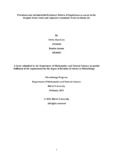Prevalence and antimicrobial resistance pattern of staphylococcus aureus in the hospital waste water and adjacent community water in Dhaka city
Abstract
Staphylococcus aureus is an important pathogen that has the potential to cause infections both in nosocomial and community settings. In terms of morphology, Staphylococcus aureus is a gram-positive bacteria that causes life-threatening diseases starting from skin infections to food poisoning. The organism was initially known to be a leading nosocomial pathogen, but epidemiologically unique variants started to prevail in the community water as well. S. Aureus has shown resistance to many antibiotics, resulting in significant mortality and morbidity.
From December 2022 to June 2023, 68 samples both from hospital and community settings were collected. From the collected samples, 33 PCR-confirmed Staphylococcus aureus isolates were found. However, 31 positive isolates were derived from community tap water but surprisingly only 2 positive isolates were derived from community tap water. It was observed that all the positive isolates were derived from community water and found to be highly resistant to aztreonam and clindamycin, whereas the isolates also showed resistance to a specific class of antibiotics (Tetracycline, Clindamycin, Ciprofloxacin, Erythromycin, and cefepime).
Our research paper will give an overview of how Staphylococcus aureus is emerging in hospital effluents and consecutively spreading to the community tap water thus resulting in causing nosocomial infections. A more detailed knowledge of the virulence and pathogenicity of Staphylococcus aureus will enable us to familiarize ourselves that how ARGs have emerged in the strain of Staphylococcus aureus, which led to its spreading in adjacent community water. It was speculated that these ARBs and ARGs were spread from hospital facilities through the hospital’s untreated wastewater.

